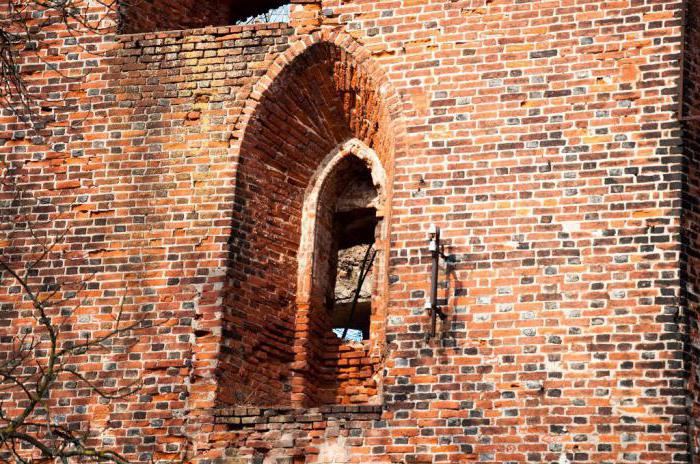The lands that make up the modern Kaliningrad region have changed their owners many times. Once this area was part of Prussia, then it belonged to the Teutonic Order, the Prussian Duchy, East Prussia, the Russian Empire and even Germany. Thanks to such a rich history, today in the vicinity of Kaliningrad there are many architectural sights. Among them you can find truly unique examples of historical architecture. A worthy example of this is the Ragnit castle in the Neman.
History of the foundation of the fortress
In the second half of the XIII century, on the site of the modern Neman of the Kaliningrad region, the Prussian fortress town of Ragnit existed. In 1277, a wooden fortification was destroyed by the wars of the Teutonic Order. A few years later, Landmaster Meinhard von Querfurt, also known as Meneck's brother, arrived in the devastated lands. The main mission of the “newcomer” and its entourage is to expand the boundaries of Christianity and carry true faith. In 1289, Brother Menek founded his own fortress on the site of the previously destroyed. The castle was called Landeshut (literally translated - "land hat"). Most likely, the fortress was named just because of the fact that it was built on a hill. Times were turbulent, and the fortification structure had to withstand enemy sieges many times. An interesting fact: already in 1326 the fortress returns its historical name - from now on it is again the castle of Ragnit.
New fortress with the old name
In 1356, the castle was again seriously damaged during the Lithuanian raid. Vinrich von Kniprodem rebuilds the fortress and orders to dig a deep moat around the walls with water. This protective measure does not help, and after 9 years the castle of Ragnit was burned. In 1397, the construction of a stone fortification begins. This castle has survived to the present day. According to the initial layout, the walls form an almost perfect square. The main building had three floors, inside there were luxurious halls and chambers, study rooms and utility rooms. New Magnet is an exquisite castle, decorated with delicate gates and large curly windows. The real decoration of the architectural ensemble is the clock tower, whose height reached about 25 meters. Entire legends are composed of a cunning system of underground passages and dungeons. Until the beginning of the XIX century, the castle of Ragnit was preserved in very good condition. When the Teutonic Order was liquidated, the district governor, the Hauptmann, and various administrative services were located in the fortress.

Beginning of the end of a beautiful era
At the beginning of the nineteenth century in an ancient fortress, it was decided to organize a prison. In 1825, she was discovered and accepted the first criminals. However, the correctional institution was not destined to exist for long within these walls. Already in 1829 there was a fire, restoration work after which lasted almost ten years. The restored Ragnit castle in the Kaliningrad region was transferred to the department of the city and district court. By the end of the nineteenth century, the fortress was abandoned and ownerless. The ancient castle was in no hurry to collapse. Without regular maintenance and repair, it was kept in excellent condition. Neman old-timers tell legends that during the Second World War the fortress was actively bombed. All shells simply bounced off the roof and did no harm to this structure. After the war, city fairs were sometimes held in the castle courtyard, and some of the well-preserved premises were used as warehouses.
How did the castle Ragnit turn into ruins? Interesting facts from the history of Soviet cinema
It's hard to believe, but the fortress, which stood for many centuries, turned into ruins in peacetime. And if many other historical monuments of architecture perish due to the lack of proper attention and restoration, Ragnit was purposefully destroyed. In 1976, director Alexei German made the film Twenty Days Without War in these places. The film crew of Lenfilm conducts a series of explosions, the result of which was significant damage to a historical monument of architecture. Nowadays it is difficult to understand a similar attitude to such an important ancient object. The beautiful Ragnit castle, whose history is filled with tragic and heroic events, turned into ruins for the sake of an ordinary nine-second episode in a not-so-popular movie. Apparently, the directors liked Herman's idea. Subsequently, two more films about the war were shot on the picturesque ruins: “Soldier and Elephant” and “I am a Russian soldier”.
Ragnit Castle today
Today, the legendary historical landmark is in a sad state. Organized excursions are not taken here, as the ruins are recognized as emergency. Nevertheless, many lovers of informal tourism come to the Kaliningrad region in order to see with their own eyes the castle of Ragnit in the Neman. From the majestic fortification to the present day, only the walls of the main building and the clock tower have survived. Brickwork crumbles, there are no internal ceilings, ruin and desolation reigns around. But still, even in this state, the fortress looks magnificent. If you decide on this tour, be sure to choose comfortable shoes and clothes.
Is there any hope of restoration?
The city of Neman is a relatively small settlement, but even there are public organizations that are not indifferent to the fate of the main local attraction. In 1992, the reconstruction of the clock tower was carried out, and in 2002 - partial conservation of the architectural monument. The regional government and local residents believe that the attraction should be preserved and restored. Perhaps, once upon a time, Ragnit Castle (Kaliningrad Region) will indeed appear in tourist avenues. To date, there is no official information about the beginning of the reconstruction. Since 2010, the attraction is in the office of the ROC MP.